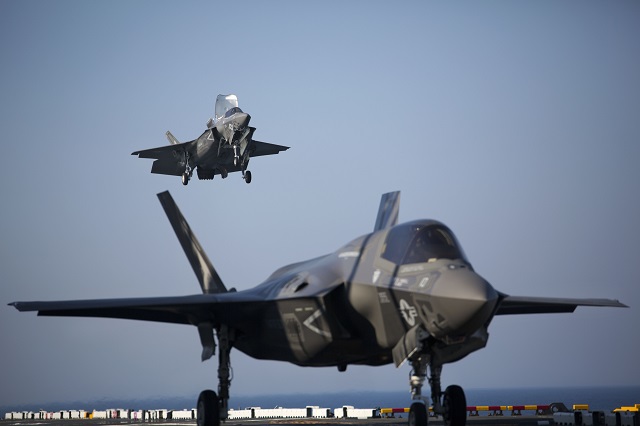|
|
|||
 ATLANTIC OCEAN (July 13, 2017) Sailors perform a chock and chain evolution on an F-35B Lightning II joint strike fighter aboard the amphibious assault ship USS Wasp (LHD 1). Wasp is underway acquiring certifications in preparation for their upcoming homeport shift to Sasebo, Japan where they are slated to relieve the USS Bonhomme Richard (LHD 6) in the U.S. 7th Fleet area of operations. (U.S. Navy photo by Mass Communication Specialist 3rd Class Zhiwei Tan/Released) ATLANTIC OCEAN (July 13, 2017) Sailors perform a chock and chain evolution on an F-35B Lightning II joint strike fighter aboard the amphibious assault ship USS Wasp (LHD 1). Wasp is underway acquiring certifications in preparation for their upcoming homeport shift to Sasebo, Japan where they are slated to relieve the USS Bonhomme Richard (LHD 6) in the U.S. 7th Fleet area of operations. (U.S. Navy photo by Mass Communication Specialist 3rd Class Zhiwei Tan/Released) |
|||
|
|
|||
|
"The aircraft and engine are large and require keen planning for hangar and flight deck spotting & storage. The best strategy for overcoming the Joint Strike Fighter roll-out challenge is to engage in continuous communications across all stakeholders," Palmer added.
After reaching initial operational capability, 10 F-35Bs were delivered to the fleet. "The Marine Corps has been successfully operating the F-35B Lightning II in the western Pacific for almost 7 months now with VMFA-121 at Marine Corps Air Station Iwakuni in Japan. Next year, we will make the first shipboard deployment for the squadron as part of a Marine Expeditionary Unit. The F-35B is a tremendous upgrade from the legacy AV-8B and these new capabilities will be demonstrated in future operations. This aircraft, unlike any others in the past, brings unique challenges due to the global logistic network associated with this platform," said Brig. Gen. Brian C. Cavanaugh, deputy commander, U.S. Marine Corps Forces, Pacific. The aircraft is a short takeoff, vertical landing (STOVL) variant, and is the world's first supersonic STOVL stealth aircraft. It's designed to operate from austere bases and a range of air-capable ships near front-line combat zones. It can also take off and land conventionally from longer runways on major bases. The F-35B will replace the AV-8B Harrier and F/A-18 Hornet. |
|||
US Navy & USMC planning for the 1st F-35B shipboard deployment within the next year
- Posted On











